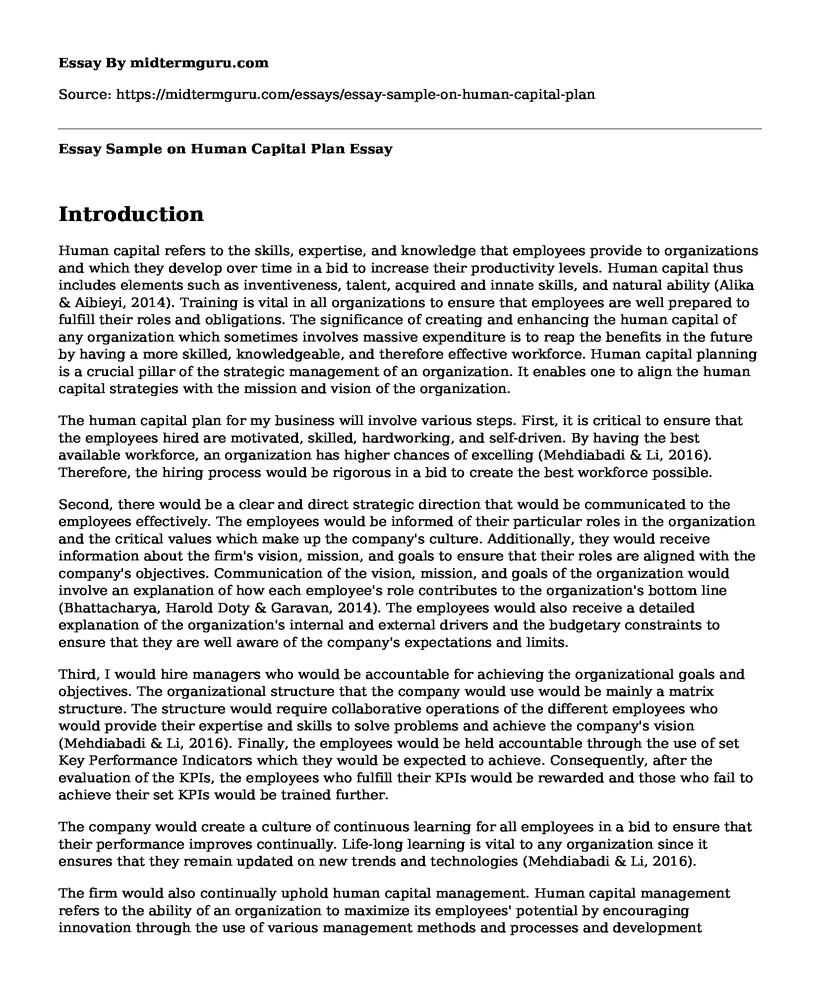Introduction
Human capital refers to the skills, expertise, and knowledge that employees provide to organizations and which they develop over time in a bid to increase their productivity levels. Human capital thus includes elements such as inventiveness, talent, acquired and innate skills, and natural ability (Alika & Aibieyi, 2014). Training is vital in all organizations to ensure that employees are well prepared to fulfill their roles and obligations. The significance of creating and enhancing the human capital of any organization which sometimes involves massive expenditure is to reap the benefits in the future by having a more skilled, knowledgeable, and therefore effective workforce. Human capital planning is a crucial pillar of the strategic management of an organization. It enables one to align the human capital strategies with the mission and vision of the organization.
The human capital plan for my business will involve various steps. First, it is critical to ensure that the employees hired are motivated, skilled, hardworking, and self-driven. By having the best available workforce, an organization has higher chances of excelling (Mehdiabadi & Li, 2016). Therefore, the hiring process would be rigorous in a bid to create the best workforce possible.
Second, there would be a clear and direct strategic direction that would be communicated to the employees effectively. The employees would be informed of their particular roles in the organization and the critical values which make up the company's culture. Additionally, they would receive information about the firm's vision, mission, and goals to ensure that their roles are aligned with the company's objectives. Communication of the vision, mission, and goals of the organization would involve an explanation of how each employee's role contributes to the organization's bottom line (Bhattacharya, Harold Doty & Garavan, 2014). The employees would also receive a detailed explanation of the organization's internal and external drivers and the budgetary constraints to ensure that they are well aware of the company's expectations and limits.
Third, I would hire managers who would be accountable for achieving the organizational goals and objectives. The organizational structure that the company would use would be mainly a matrix structure. The structure would require collaborative operations of the different employees who would provide their expertise and skills to solve problems and achieve the company's vision (Mehdiabadi & Li, 2016). Finally, the employees would be held accountable through the use of set Key Performance Indicators which they would be expected to achieve. Consequently, after the evaluation of the KPIs, the employees who fulfill their KPIs would be rewarded and those who fail to achieve their set KPIs would be trained further.
The company would create a culture of continuous learning for all employees in a bid to ensure that their performance improves continually. Life-long learning is vital to any organization since it ensures that they remain updated on new trends and technologies (Mehdiabadi & Li, 2016).
The firm would also continually uphold human capital management. Human capital management refers to the ability of an organization to maximize its employees' potential by encouraging innovation through the use of various management methods and processes and development methods (Alika & Aibieyi, 2014). The company's human capital management goals would, therefore, include the collection and assessment of data needed in the attainment, retaining, development, and maintenance of the talented and top performing workforce and the identification of methods that the firm can employ to attain a competitive advantage. The plan would be implemented and managed with the help of the managers and through the use of various KPIs.
Conclusion
In conclusion, the human capital plan would aim to increase employees' productivity by aligning their roles to the firm's vision and mission. Additionally, it would involve continuous employee training to enhance their skills and knowledge. Finally, there would be rewarding of employees who reach their set KPIs to increase their motivation levels.
References
Alika, I., & Aibieyi, S. (2014). Human Capital: Definitions, Approaches and Management Dynamics. Journal of Business Administration and Education, 5(1), 56-70. Retrieved from http://www.infinitypress.info/index.php/jbae/article/viewFile/352/283
Bhattacharya, M., Harold Doty, D., & Garavan, T. (2014). The Organizational Context and Performance Implications of Human Capital Investment Variability. Human Resource Development Quarterly, 25(1), 87-113. doi: 10.1002/hrdq.21182
Mehdiabadi, A., & Li, J. (2016). Understanding Talent Development and Implications for Human Resource Development. Human Resource Development Review, 15(3), 263-294. doi: 10.1177/1534484316655667
Cite this page
Essay Sample on Human Capital Plan. (2022, Nov 07). Retrieved from https://midtermguru.com/essays/essay-sample-on-human-capital-plan
If you are the original author of this essay and no longer wish to have it published on the midtermguru.com website, please click below to request its removal:
- Financial Evaluation Paper on Costco Wholesale Corporation
- Canadian Tire Corporation Evaluation Essay
- Paper Example on Social Performance of an Organization
- Paper Example on Paradoxical Thinking Technique and How It Affects Organizations
- Reviewing Forms for Compliance: Frequency & Preparedness - Essay Sample
- High Employee Turnover: Solutions for Organizations - Essay Sample
- USA Trade Agreement With Latin American Countries - Essay Sample







